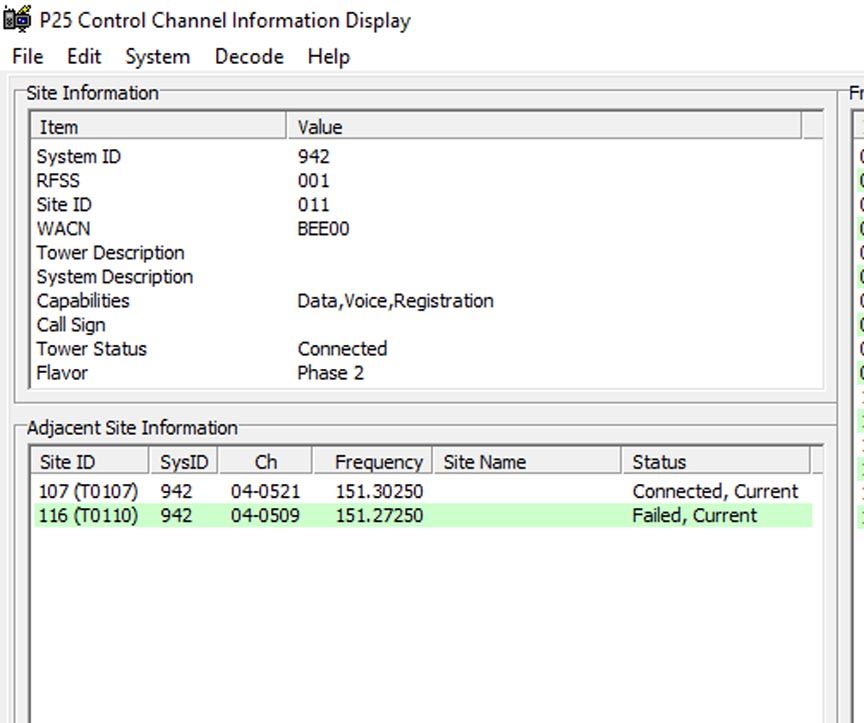I'm still kinda new to the Phase II stuff and the 436 BCD, I know how talkgroups work, but not sure about the radio affiliations by talkgroups you've posted here. Are those the individual radios on the system that have shown up on those talkgroups? Do those users show up on the 436 display?
Radio affiliations and radio ID's can be found on most trunked systems...not just a P25 phase 2 system.
A radio ID (or RID) is a unique identifier for a radio on the system. You can see this pop up on a BCD436 when a unit transmits on a clear talkgroup. The BCD436 ignores encrypted transmissions.
If you are using some kind of system tracking software (like Unitrunker, Pro96com, or something else), you will see lists generated in real time of active talkgroups that have had a radio affiliation, voice, or data traffic. An affiliation just means that a radio has been turned to that channel and, in the case of this system, is registered with the particular tower site you are tracking. It does not mean anyone is talking. Voice transmissions are the only time you will see something pop up on your 436...although mine will stop briefly on an encrypted talkgroup when someone transmits sometimes (on my local county system)...just a brief pause less than a second. It will then resume scanning because of the encryption.
How is this stuff useful?
Talkgroups and radio ID's can be completely random. Although, most sys admins have some sort of pattern to it all. Based on the various postings and PM's from folks up in the NW, there appears to be patterns to the layout of the new system as far as talkgroup numbers and radio ID numbers. This is, of course, incredibly difficult to confirm since all of PSP is encrypted. Since other agencies may or may not be clear when they come on board, keeping track of these numbers is a good idea.
The air to ground 700 system is inconsistent when it comes to the talkgroup numbering, but there are patterns for the RIDS.
When things are organized, it can give you ideas as to who is who, even with encryption. For instance, RID's on federal VHF frequencies can help identify which alphabet soup agency the frequency is being used by if you've paid attention to the RIDS that show up in the clear on other known frequencies. The same sort of thing can be done with this system.
Also, with the geographic isolation of not having significant wide area simulcasts on this new system, you could even go as far as making a guess on which talkgroup ID belongs to a particular PSP station. Knowing there are three stations in Erie County and that there are maybe two talkgroups that show up on the Erie tower frequently with unique sets of RIDs, you can surmise that one is PSP Erie and the other is PSP Girard. If there is a third talkgroup that shows up on Erie tower and other nearby towers regularly, that could be Corry since they patrol the eastern end of the county. Then, a second lesser used talkgroup sharing RIDS with one of the previous talkgroups could likely be the station tac channel. If you see a talkgroup used periodically with RIDs from all the dispatch groups in Troop E, that would probably be E Tac 1. Right now, on Opensky, there are "troop tacs" instead of the old statewide tac 1, 2, 3 from the VHF days. But, again, with the fulltime encryption, confirming anything for PSP would be difficult without an official source of info.
Using voice traffic clues and RID's can help flesh out clear talkgroups, though. Seeing the same RIDS routinely on several talkgroups will most likely indicate they belong to the same agency. Sure, there could be some exceptions since there are some global statewide talkgroups that show up in all radios. But, historically, their used is exceedingly rare...normally just for special preplanned events. And, even there, you're most likely going to see agencies use their own talkgroups for their own agency specific functions. I thought for sure I would see use of the global talkgroups when I was working the Papal detail in Philly. But, DEP, National Guard, PSP, etc all worked on their own channels since they had distinct functions.
It helps a bit to know how agencies currently have their fleetmaps set up. But, even that won't be a perfect resource because agencies have been asked to review their fleetmaps and consider changes if they find there are talkgroups on OpenSky that have never been used or seem superfluous. So, going from the old system to the new system, there may not be complete matching of the fleetmap...it will depend on the agency.
Last edited:



